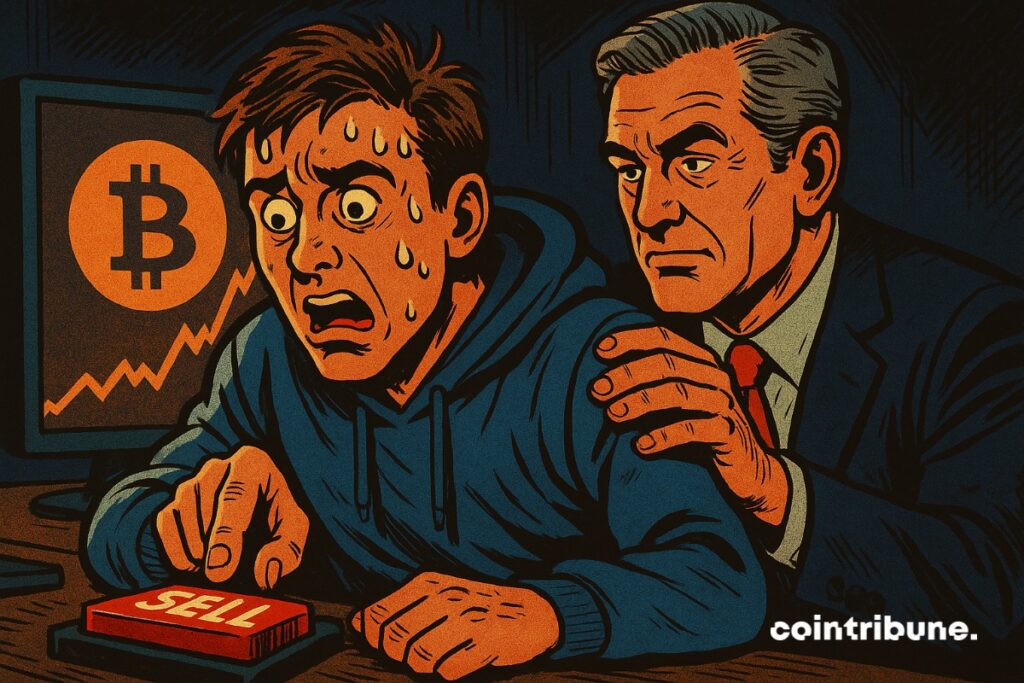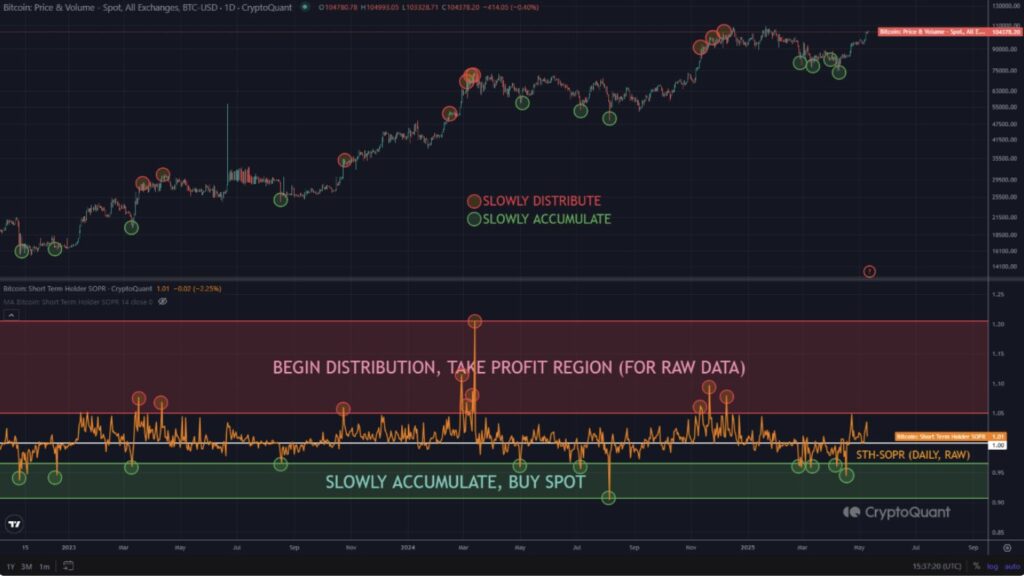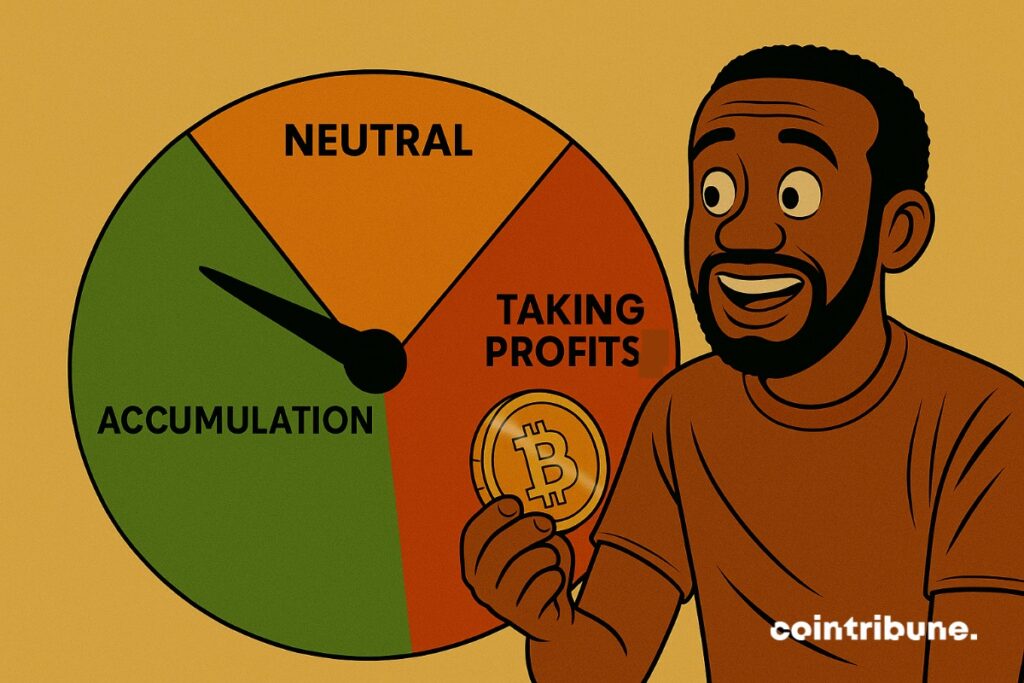Selling Your Bitcoins Now Would Be A Big Mistake According To This Indicator
Bitcoin surpasses $105,000 and some investors are already thinking about selling. However, according to a recognized expert, no clear signal justifies this. A key indicator shows that the bulls are still in the game. Here is how to interpret this signal… and avoid giving in to panic.

In brief
- The STH-SOPR remains below the critical threshold, signaling that no massive profit-taking is underway on bitcoin.
- Inflows into Bitcoin ETFs support demand and stabilize the market.
- CryptoQuant recommends a gradual selling strategy to maximize gains.
- On-chain indicators confirm a still active bullish cycle on bitcoin, with no sign of an imminent peak.
Bitcoin: the STH-SOPR, thermometer of euphoria or caution
The STH-SOPR (Spent Output Profit Ratio for short-term holders) is used to measure profits realized on the sale of bitcoins held for less than 155 days. When it exceeds the threshold of 1 excessively, it indicates that bitcoin holders are taking their gains, often near a peak. Conversely, when it remains close to or below 1, this signals an accumulation phase.
Currently, data shows that the STH-SOPR remains moderate, far from the red zones of euphoria observed during market highs. BTC therefore retains room for growth, supported by an still healthy market structure. This technical signal helps to avoid rushed sales during consolidation phases.

Why bitcoin has not yet reached its profit-taking zone
According to CryptoQuant, the bitcoin market remains far from a distribution phase. The STH-SOPR has not crossed the critical threshold signaling excess profit-taking. Several factors strengthen this reading: institutional interest remains supported by inflows into Bitcoin ETFs, and miners continue to store part of their production.
Moreover, on-chain analysis demonstrates market resilience that absorbs selling pressure without imbalance. As long as the red zone of the STH-SOPR is not reached, the chances of an extension of the bullish cycle remain high. This indicates that BTC holders still favor a waiting strategy rather than a massive exit.

Planning a gradual exit: the CryptoQuant method
CryptoQuant recommends a gradual strategy to secure gains on bitcoin. This approach, symmetrical to that of progressive accumulation, allows to benefit from the bullish market without trying to sell at the absolute peak. Here are the key advantages of this method:
- Reduced stress related to perfect timing;
- Better exposure to prolonged rallies;
- Smoothing of short-term volatility effects;
- Enhanced discipline in portfolio management.
This exit framework is based on objective indicators, such as the STH-SOPR, avoiding emotional decisions. Consequently, investors can secure profits as distribution signals emerge, without exiting prematurely from an active bullish cycle.
What this means for investors in 2025
Current market analysis suggests that bitcoin could continue its upward trend as long as technical signals like the STH-SOPR remain favorable. For investors, this implies dual vigilance: monitor key indicators while maintaining a consistent strategy.
Additionally, buying pressure supported by Bitcoin ETFs and the absence of panic selling reinforce the idea of a market building towards a peak, rather than in decline. Premature profit-taking could deprive holders of significant gains if momentum continues. At this stage, patience remains a strategic advantage for bitcoin holders.
How to interpret on-chain indicators before selling your bitcoin
Before any bitcoin selling decision, on-chain data offer reliable benchmarks to gauge market momentum. Here are the main signals to watch:
- STH-SOPR: indicates if recent sellers are realizing profits or not;
- NUPL (Net Unrealized Profit/Loss): measures latent profits on the network;
- Accumulation ratio by age bracket: signals if “whales” are holding or distributing;
- Exchange balances: increase = potential selling pressure; decrease = long-term storage;
- ETF flows: reflect institutional interest in real-time.
Cross-interpretation of these data helps anticipate cycle reversals without depending on market emotions. To navigate the 2025 bull run, relying on these benchmarks becomes a decisive decision-making lever.
As experts are already considering 3 inevitable scenarios for the 2025 altseason, Bitcoin remains supported by solid on-chain indicators, and nothing yet signals a definitive peak. Betting on data, not emotions, allows one to stay aligned with the market. The real question now: should one aim for a top or secure gains in stages?
Maximize your Cointribune experience with our "Read to Earn" program! For every article you read, earn points and access exclusive rewards. Sign up now and start earning benefits.
The world is evolving and adaptation is the best weapon to survive in this undulating universe. Originally a crypto community manager, I am interested in anything that is directly or indirectly related to blockchain and its derivatives. To share my experience and promote a field that I am passionate about, nothing is better than writing informative and relaxed articles.
The views, thoughts, and opinions expressed in this article belong solely to the author, and should not be taken as investment advice. Do your own research before taking any investment decisions.